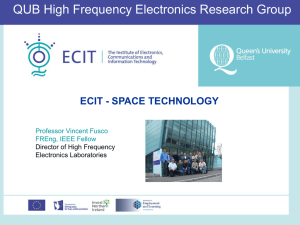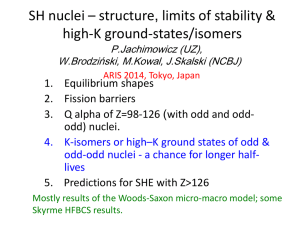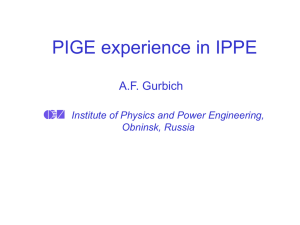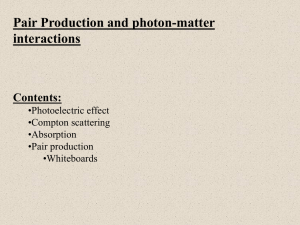クォーク模型によるバリオン 8 重項の バリオン間相互作用
advertisement
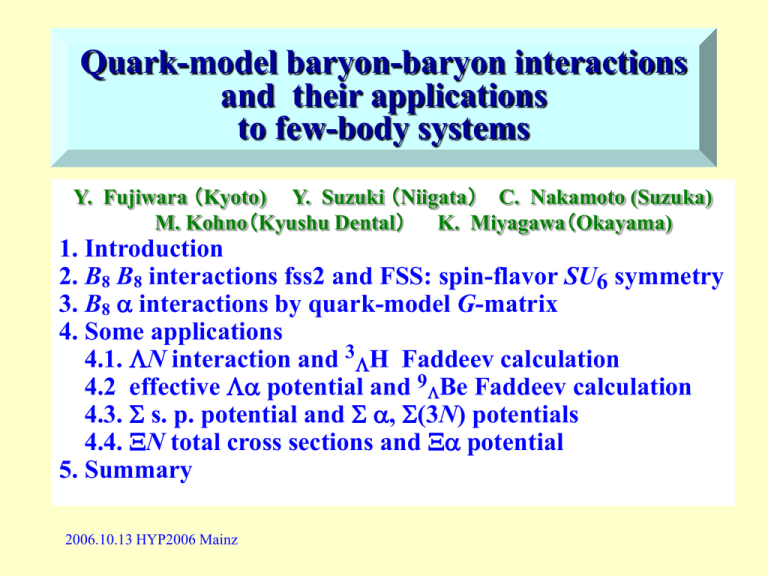
Quark-model baryon-baryon interactions
and their applications
to few-body systems
Y. Fujiwara (Kyoto) Y. Suzuki (Niigata) C. Nakamoto (Suzuka)
M. Kohno(Kyushu Dental) K. Miyagawa(Okayama)
1. Introduction
2. B8 B8 interactions fss2 and FSS: spin-flavor SU6 symmetry
3. B8 interactions by quark-model G-matrix
4. Some applications
4.1. N interaction and 3H Faddeev calculation
4.2 effective potential and 9Be Faddeev calculation
4.3. s. p. potential and , (3N) potentials
4.4. N total cross sections and potential
5. Summary
2006.10.13 HYP2006 Mainz
Oka – Yazaki (1980)
B8B8 interactions by fss2
Phys. Rev. C64 (2001) 054001
Phys. Rev. C65 (2002) 014001
A natural and accurate description of NN, YN,
YY interactions in terms of (3q)-(3q) RGM
• Short-range repulsion and LS by quarks
• Medium-attraction and long-rang tensor by S, PS and V
meson exchange potentials (fss2) (Cf. FSS without V)
Phys. Rev. C54 (1996) 2180
Model Hamiltonian
H =∑ 6i=1 (mi+pi2/2mi)
+∑ 6i<j (UijConf+UijFB+∑βUijSβ
+∑βUijPSβ + ∑βUijVβ)
f(3q)f(3q)|E-H|A {f(3q)f(3q)c(r)}=0
QMPACK homepage
PPNP in press
http://qmpack.homelinux.com/~qmpack/index.php
2006.10.13 HYP2006 Mainz
Arndt : SAID
Nijmegen : NN-OnLine
Lippmann-Schwinger (LS) RGM
P.T.P. 103
(2000) 755
Solve [ - H0 - VRGM() ] c=0 with VRGM()=VD+G+ K
in the mom. representation ( = E - Eint )
Born kernel qf|VRGM() |qi T-matrix, G-matrix
1) non-local
2) energy-dependent
3) Pauli-forbidden states in N - N (I=1/2), - N
- (I=0), - (I=1/2) 1S0 : i.e. SU3 (11)s : Ku=u
3-cluster Faddeev formalism using VRGM()
G 0 ( E )T ( E h , )( )
u | P u | 0
self-consistency
equation for
P | h V
RGM
P.T.P. 107
(2002) 745;
993
( ) | P
B8 interaction by quark-model G-matrix
: “(0s)4”
G (p, p’; K, , kF)
k’=p’- p , q’=(p+p’)/2
G (k’, q’; q1, q’)
k=k’
- cluster folding
q1=q for direct and knock-on
V (k, q)
B8 relative q’
incident q1
=0.257 fm-2
in total c. m.
kF=1.35 fm-1
VW (R, q) : Wigner transform
k=pf - pi , q=(pf+pi)/2
V (pf , pi)
U(R)=VW(R, (h2/2)(E-U(R))
Lippmann - Schwinger equation
exact EB , (E)
2006.10.13 HYP2006 Mainz
Transcendental equation
Schrödinger equation
EBW , W(E)
“constant K , , kF”
n RGM by G-matrix of fss2
n sactt. phase shift
S1/2
P3/2
P1/2
2006.10.13 HYP2006 Mainz
exp
q1=0
q’=3/5 kF
kF=1.35 fm-1
B8B8 systems classified in the SU3 states with (l, )
S
B8B8(I)
1E, 3O (P =symmetric)
3E, 1O (P =antisymmetric)
0
NN(0)
NN(1)
―
(22)
(03)
―
‐1
N
N(1/2)
N(3/2)
‐2
N(0)
N(1)
(0)
(1)
(2)
‐3
(1/2)
(3/2)
‐4
(0)
(1)
(11)s
1
10
1
10
9
1
1
[(11)s+3(22)]
[3(11)s‐(22)]
(22)
2
1
2
1
(11)s+ 2 30(22)+ 2 2 (00)
5
3
1
1
(11)
‐
(22)+
(00)
s
10
2
5
3
(11)s+ 52 (22)
5
2
3
ー 5 (11)s+ 5
(22)
1
3
3
(11)
-
(22)-
(00)
2
10
8
s
5
―
(22)
1
10
1
10
2
1
2
―
(22)
complete Pauli forbidden
―
(11)a
1
[‐(11)a+ (30)+(03)]
3
1
[(30)‐(03)]
2
―
1
[2(11)a+ (30)+(03)]
6
―
1
[(11)s+3(22)]
[3(11)s‐(22)]
(22)
[‐(11)a+(03)]
[(11)a+(03)]
(30)
[‐(11)a+(30)]
[(11)a+(30)]
(03)
(30)
―
(30)
almost forbidden (=2/9)
Spin-flavor SU6 symmetry
1. Quark-model Hamiltonian is approximately SU3 scalar
・ no confinement contribution (assumption)
・ Fermi-Breit int. … quark-mass dependence only
・ EMEP … automatic SU3 relations for coupling constants
phenomenology Cf. OBEP: exp data g, f, … (integrated)
2. -on plays an important role through SU3 relations and FSB
3. effect of the flavor symm. breaking (FSB) by ms>mud , B, M masses
Characteristics of SU3 channels
1S, 3P (P-symmetric)
(22) attractive
pp
3S, 1P (P-antisymmetric)
(03) strongly attractive
np
(11)s strongly repulsive N(I=1/2) (30) strongly repulsive N(I=3/2)
(00) strongly attractive
H-particle channel
(11)a weakly attractive N(I=0)
“only this part is ambiguous”
1S
0
phase shifts for B8B8 interactions
with the pure (22) state (fss2)
S=‐2
S=0
1S
0
S=‐3
S=‐1
S=‐4
(22)
3S
1
phase
shifts
NN
3S
(3/2)
fss2
1
(03)
NN (03) central only
(no tensor)
(11)a
N (0) (11)a : weakly
(0)
attractive
(30)
N (3/2)
(30) : Pauli
repulsion
+p differential cross sections
and +p, p asymmetries a()
Ahn et al. (KEK-PS E251, E289)
NP A648(1999)263, A761(2005)41
350 MeV/c plab 750 MeV/c
Kurosawa et al. (KEK-PS E452B)
KEK preprint 2005-104 (2006)
+p
+p elastic
aexp=0.44±0.2
at p=800±200 MeV/c
Kadowaki et al. (KEK-PS E452)
Euro. Phys. J. A15 (2002) 295
p elastic
reported by
K. Nakai
N interaction by fss2
Backward/Forward ratio
P-wave
N is weakly
attractive
fss2
FSS
N - N coupling : 3S1 + 3D1 by one- tensor
1P + 3P by FB LS (-)
1
1
2006.10.13 HYP2006 Mainz
from 3He
Faddeev
3
H
NN-NN CC Faddeev
(hypertriton)
Phys. Rev. C70, 024001 (2004)
N on-shell properties are directly reflected
1S / 3S relative
0
1
“deuteron” Λ(∑0 )
u
strength
s
d
exp’t
u u
d = 2.22 MeV
~5 fm
d
B=130 ±50 keV
p
close to NSC89 P (%)
~2 fm u
n
d
d
fss2 289 keV 0.80
FSS 878 keV 1.36
NN = 19.37 – 21.03 = -1.66
|d |= 17.50 – 19.72 = -2.22 (MeV)
2006.10.13 HYP2006 Mainz
150 channel calculation
N 1S0 and
model
3S
1
effective range parameters
FSS
as (fm) rs (fm)
-5.41 2.26
at (fm) rt (fm)
-1.03 4.20
fss2
-2.59
2.83
-1.60
NSC89 -2.59
2.90
“fss2” -2.15
3.05
878
1.36
3.01
289
0.80
-1.38
3.17
143
0.5
-1.80
2.87
145
0.53
“fss2”: m c2 = 936 MeV 1,000 MeV
B (keV)
fss2
“fss2”
6 ch (S)
15 ch (SD)
102 ch (J4)
150 ch (J6)
137
198
288
289
44
85
145
145
2006.10.13 HYP2006 Mainz
B(keV) P(%)
favorable for 4H (1+)
Effect of the higher partial
waves is large
90 – 60 keV
vs. 20 – 30 keV in NSC89
BΛexp=130 ±50 keV
effective local potentials
by G-matrix B8B8 interaction
effective potentials
quark-model N-N
ND
EB (exact)
-3.62 MeV
-3.18 MeV
EBexp=3.120.02
MeV
Cf. U(0)=‐46 (FSS), ‐48 (fss2) MeV
in symmetric matter
(3.04 MeV) 2+
2 Faddeev for 9Be
Phys. Rev. C70, 024002, 0407002 (2004)
(0) 92 keV 0+
8Be
+ +
RGM kernel (MN3R)
effective pot. (SB u=0.98)
exp’t
-3.120.02 MeV
3067(3) keV 3/2+ 3026 keV
+5He
3024(3) keV 5/2+ 2828 keV
-6.620.04 MeV +
1/2
9
Be
calc.
l s splitting by N LS Born kernel
198 keV (fss2 quark+), 137 keV (FSS) : 3 5 times too large
Tamura et al. (BNL E930)
Eexp(3/2+ - 5/2+) = 43 5 keV Akikawa,
Phys. Rev. Let. 88, 082501 (2002)
2006.10.13 HYP2006 Mainz
ls splitting of 9Be by 2 Faddeev using
quark-model G-matrix LS Born kernel
0.5 0
kF (fm-1)
1.07
‐10.5
-1.9
188
7
G-matrix fss2 (cont)
S (MeV fm5) FSS (cont)
Faddeev
E (keV)
fss2 (cont)
FSS (cont)
E exp (keV)
0.70
0
N Born
1.20
1.35
‐10.6 ‐10.7
-2.9
-3.6
194
198
34
59
43 5
-10.9
-7.8
198
137
FSS (cont) reproduces E exp at kF=1.25 fm-1 !
P-wave N-N coupling by LS(-) is important.
S-meson LS in fss2 is not favorable.
2006.10.13 HYP2006 Mainz
potentials (VWC (R, 0)) by quark-model
G-matrix interaction
FSS
fss2
I=3/2
I=3/2
total
total
I=1/2
I=1/2
The Pauli repulsion of N(I=3/2) 3S1 is very strong.
2006.10.13 HYP2006 Mainz
(3N) potentials by quark-model G-matrix
interaction ( 0+, T=1/2 channel)
3/2
V S ( 3 N ) ( S = 0, T = 1 / 2) = (4 / 3)V s
FSS
EB(exact)=-3.79 MeV
+ (3 / 2)V t
1/ 2
+ (1 / 6)V s
fss2
EB(exact)=-5.70 MeV
consistent with 4He (0+) resonance
2006.10.13 HYP2006 Mainz
1/ 2
(3N): (0s)3
=0.22 fm-2
q1=0
(-, K+) inclusive spectra on 28Si
exp: Noumi et al. PRL 89, 072301 (2002) ; 90, 049902 (E) (2003)
Saha et al. Phys. Rev. C70, 044613 (2004)
poster session
by M. Kohno
Repulsive U (q) in symmetric nuclear matter is experimentally confirmed.
potentials (VWC (R, 0)) by quark-model
G-matrix interaction
fss2
FSS
I=1
total
total
I=0
I=0
Some attraction in the surface region.
I=1
+3.7
Tamagawa et al. (BNL-E906)
-N (in medium) = 30.7±6.7 -3.6 mb Nucl. Phys. A691 (2001) 234c
et al.
(eikonal approx.)= 20.9±4.5 +2.5 mb Yamamoto
Prog. Theor. Phys. 106 (2001)363
-2.4
-p /-n =1.1 +1.4+0.7
-0.7 -0.4 at plab=550 MeV/c
FSS
fss2
Ahn et al.
Phys. Lett. B
633 (2006) 214
More experiments are needed.
Summary
Quark-model description for the baryon-baryon
interaction is very successful to reproduce many
experimental data. In particular, the extension of
the (3q)-(3q) RGM study for the NN and YN
interactions to the strangeness S=-2, -3, -4 sectors
has clarified characteristic features of the B8B8
interactions. The results seem to be reasonable if
we consider
1) spin-flavor SU6 symmetry
2) weak π-on effect in the strangeness sector
3) effect of the flavor symmetry breaking
We have analyzed B8, B8(3N) interactions based on
the G-matrix calculations of fss2 and FSS.
2006.10.13 HYP2006 Mainz
Characteristics of fss2 and FSS
S=0 ・ triton binding energy … fss2: +150 keV (3 body force?)
S=‐1 p and +p interactions are progressively known.
・ + p total and differential cross sections and
polarization … fss2, FSS
・ N 1S0 and 3S1 attraction (relative strength)
( 3H Faddeev calculation: 289 keV for fss2)
・ small ls splitting in 9Be excited states (FSS)
・ N (I=1/2 1S0), N (I=3/2 3S1) repulsion
repulsive s. p. and potentials … fss2, FSS
S=‐2 interaction is not much attractive !
・ interaction |V|<|VN|<|VNN|
B 1 MeV (Nagara event 6He) … fss2
・ N in-medium total cross section (fss2, FSS)
… strong isospin dependence of s.p. potential
・ N (I=0 3S1): (11)a 0 or weakly attractive (fss2, FSS)
vs. ESC04(d): strongly attractive

